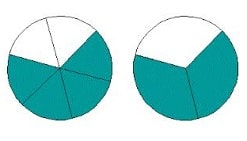Before entering fully into the meaning of the equivalent term, we are going to proceed to discover its etymological origin. In this case, we can establish that it derives from Latin, since it is the result of the sum of the following components of said language:
-The word "aequus", which means "equal."
-The verb "valere", which can be translated as "remain strong."
-The suffix "-ente", which is used to indicate "agent".
Two elements are equivalent when they are equivalent: that is, when they are worth the same or have the same value or capacity .
 For example: "To prepare this dessert, we must include a small amount of cocoa in the mixture, the equivalent of a teaspoon" , "The debt that the national State has just contracted is equivalent to the Gross Domestic Product of Albania" , "If the company does not refund your money, it should give you products for an equivalent value .
For example: "To prepare this dessert, we must include a small amount of cocoa in the mixture, the equivalent of a teaspoon" , "The debt that the national State has just contracted is equivalent to the Gross Domestic Product of Albania" , "If the company does not refund your money, it should give you products for an equivalent value .
Synonyms for equivalent include equal, similar, even, similar, similar and even corresponding. On the other hand, among its antonyms we can highlight different, different and also opposite.
Suppose a person earns a salary of 50,000 pesos . To celebrate his birthday, he decides to organize a big party, on which he spends 100,000 pesos . It can be said, therefore, that this subject spent the equivalent of two of his salaries in organizing the event.
Let's take another case to understand the notion of equivalent. A failure in the electrical distribution generates a voltage spike and damages a family's television, making it unusable. In response to the claim of the victims, the energy company undertakes to provide them free of charge with another television equivalent to the one destroyed: the same number of inches, with similar characteristics, etc.
In the field of chemistry , it is called equivalent to the minimum mass that one body needs to combine with another. Equivalent is also the number that allows the representation of the weight of said mass, considered based on a body that is taken as a type.
Specifically, we can establish that it is the mass of a substance that reacts or is replaced with one mole of electrons in what is a redox type reaction or with one mole of hydrogen ions in an acid-base class reaction. . However, it can also be the mass that is released or deposited when the circulation of what is one mole of electrons occurs.
In this scientific field, there is talk, therefore, of what is known as equivalent weight, which we can highlight that it began to be talked about in the 18th century, specifically in 1777, by Carl Friedrich Wenzel.
In the same way, it is interesting to know that the equivalent weight can be calculated from what are molar masses and that it has both mass units and dimensions.
For geometry , two solid bodies or two figures are equivalent when they have a different shape but the same volume or area.
